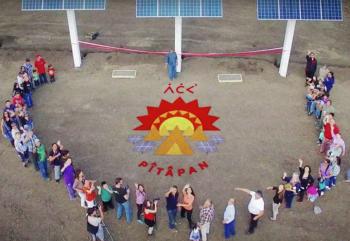Image Caption
By Shari Narine
Windspeaker Contributor
EDMONTON
The work of First Nations in solar energy is going to be the focus of a panel discussion on May 11. Desmond Bull, a councillor with the Louis Bull Tribe, is one of the panelists.
Bull has spearheaded green energy development on his First Nation along with the training of band members in the solar energy industry.
The First Nation accesses solar power for the health building, Head Start education building, adult training education centre, and the fire hall/public works building.
Bull also served on the province’s Energy Efficiency Advisory Panel, which made its recommendations to Shannon Phillips, minister responsible for the Climate Change Office, late last year.
In an earlier interview with Windspeaker.com, Bull said he wanted to see First Nations actively involved with green energy development.
“I don’t want to see what happened with the oilsands, where First Nations’ manpower was really waiting to get on board with that industry and nothing ever really effectively happened,” he said.
Rob Harlan, executive director with the Solar Energy Society of Alberta, says opportunities are numerous for Indigenous communities and this panel will provide some “inspiring examples.”
He notes that the province has a grant program in place—the Alberta Indigenous Solar Program— which is designed to help Indigenous communities or organizations install solar photovoltaic systems on facilities owned by the community or organization.
“Alberta has an incredible solar resource, which we’re just beginning to turn to as a source for electricity and other needs, and it just lines up with what a lot of First Nations communities already believe in, connection with nature, living lightly on the land, that kind of thing,” said Harlan.
He adds that there is “tremendous potential” with solar energy as it can be undertaken both as a smaller project and on a large scale.
Most solar energy systems, said Harlan, use the utility system to store energy. When the solar energy produced is more than the producer can use, that energy is fed into the electricity grid for someone else to use and is registered as a credit for the producer.
In the winter time, when the sun doesn’t produce enough energy, the electricity is bought back.
At this point, he says, the only place where it is cost effective to have solar energy batteries is in isolated northern communities as a way to offset the high cost of flying in or trucking in diesel.
The panel, which also includes Vickie Wetchie, economic development director for Montana First Nation and Paul Wyminga, director of Aboriginal Development for the provincial government, will be educational for both Indigenous and non-Indigenous attendees.
“A lot of the projects apply to non-Indigenous or Indigenous people as well,” said Harlan.
The province also offers an Alberta Municipal Solar Program and is in the midst of a grant review for the On-Farm Solar Photovoltaics Program.
As well the government plans to launch a residential and commercial solar program this summer, which will offer rebates to homeowners, businesses and non-profits that install solar photovoltaic systems.
“There’s numerous opportunities for everybody to get into the game, whether it just be homeowners or someone with a business who wants a solar system or even a large developer or a farmer who has a lot of land,” said Harlan.
The free public seminar on First Nations Solar takes place Thursday at MacEwan University in Edmonton.
Check out https://solaralberta.ca/events/first-nations-solar

